Ego Pharmaceuticals: A Report on Business Level and Global Strategies
VerifiedAdded on 2022/12/14
|8
|1063
|293
Report
AI Summary
This report provides an analysis of Ego Pharmaceuticals, focusing on the business-level and global strategies the company employs. The report suggests that Ego Pharmaceuticals should adopt a differentiation strategy to gain a competitive advantage in the skincare market. This strategy will allow the company to create unique and attractive products through innovation, research and development, and effective marketing. The report also examines the international strategy pursued by Ego Pharmaceuticals, which is identified as an international strategy, expanding its presence across multiple countries. The advantages of this global approach include expanded customer reach and business diversification. The report also acknowledges the disadvantages, such as challenges related to foreign cultures and government regulations. The report concludes by referencing relevant academic sources to support its findings.
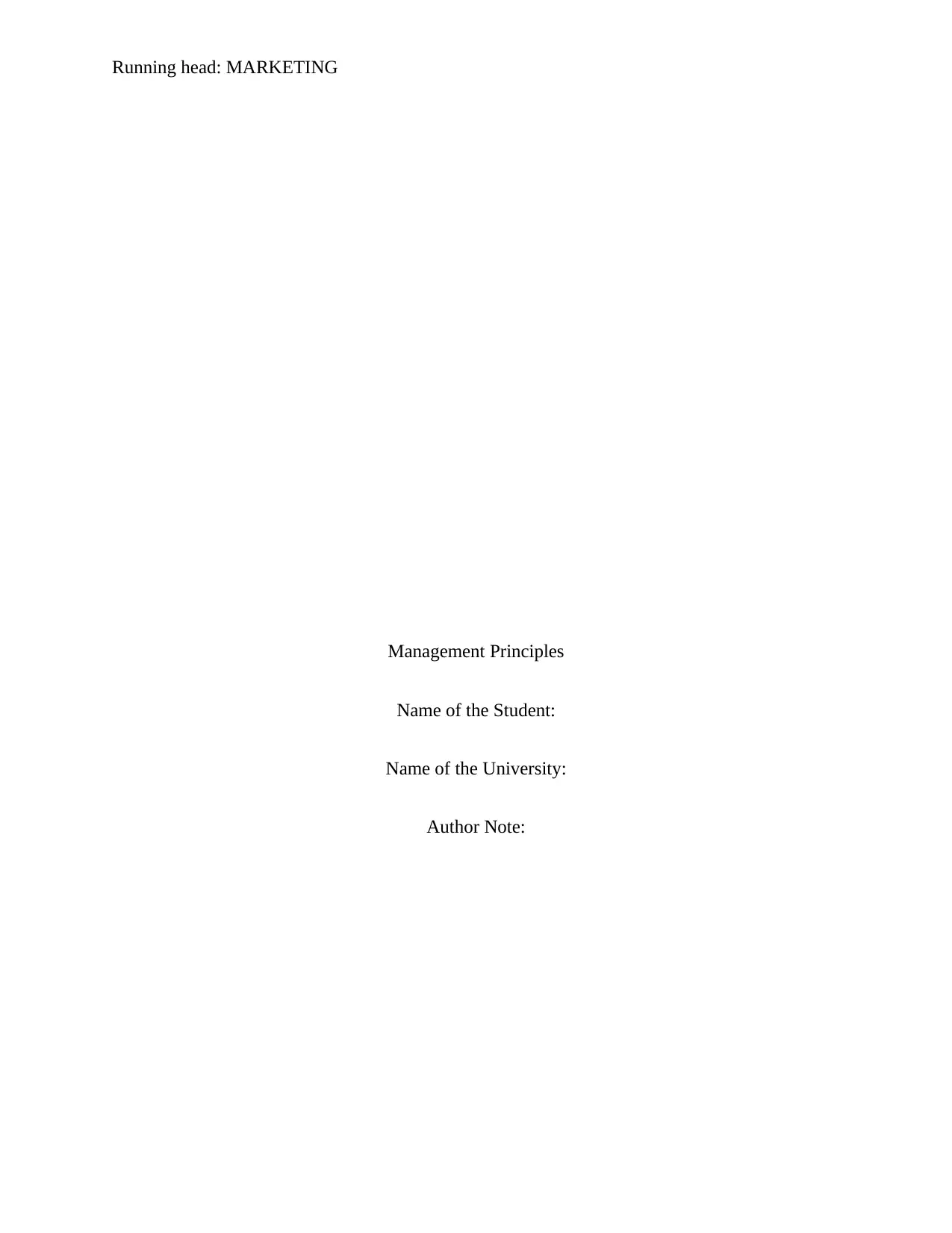
Running head: MARKETING
Management Principles
Name of the Student:
Name of the University:
Author Note:
Management Principles
Name of the Student:
Name of the University:
Author Note:
Paraphrase This Document
Need a fresh take? Get an instant paraphrase of this document with our AI Paraphraser
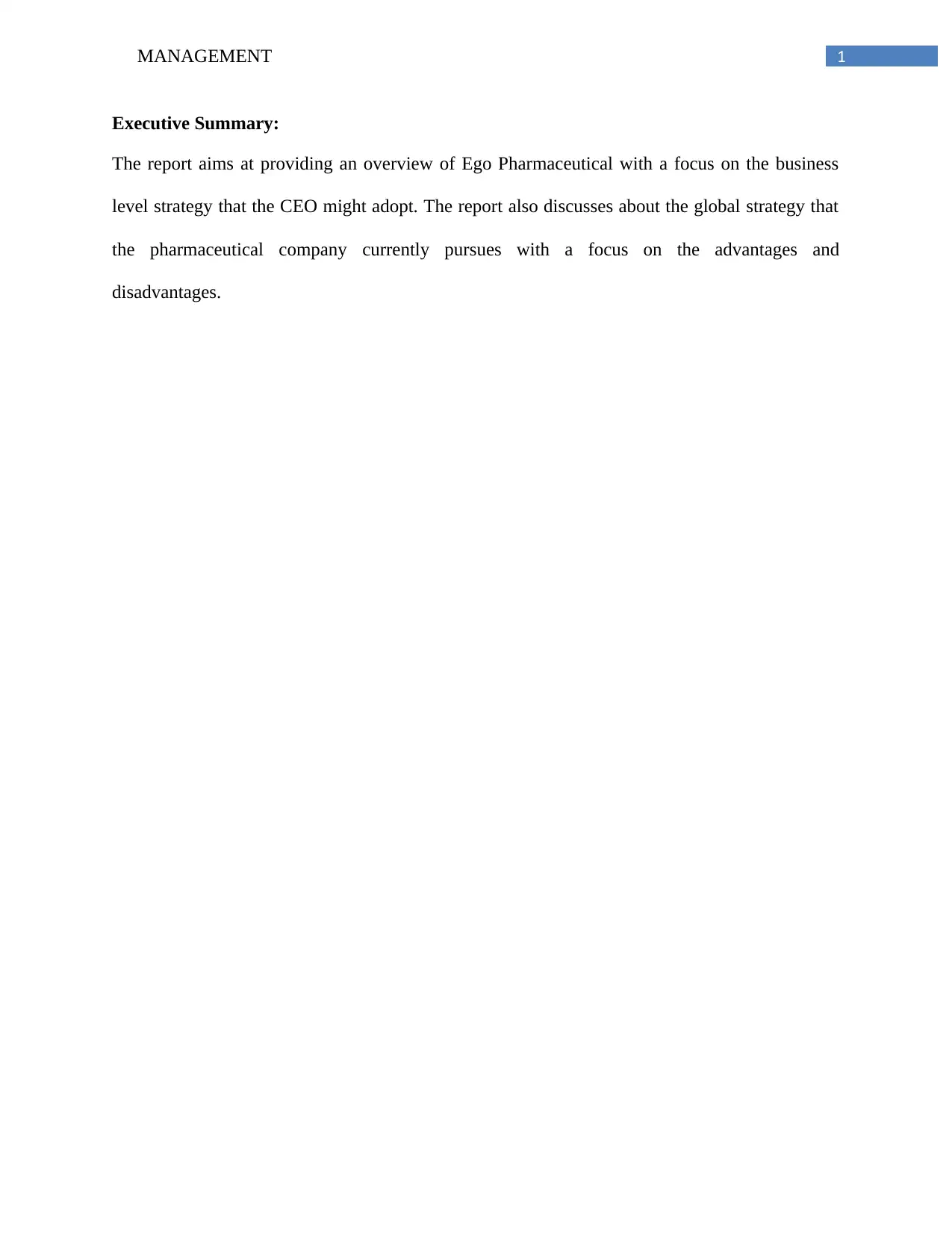
1MANAGEMENT
Executive Summary:
The report aims at providing an overview of Ego Pharmaceutical with a focus on the business
level strategy that the CEO might adopt. The report also discusses about the global strategy that
the pharmaceutical company currently pursues with a focus on the advantages and
disadvantages.
Executive Summary:
The report aims at providing an overview of Ego Pharmaceutical with a focus on the business
level strategy that the CEO might adopt. The report also discusses about the global strategy that
the pharmaceutical company currently pursues with a focus on the advantages and
disadvantages.

2MANAGEMENT
Table of Contents
1. a. Business Level Strategy that CEO of Ego Pharmaceuticals Should Adopt.............................3
1b.(i). Global Strategy Pursued by Ego Pharmaceuticals...............................................................4
(ii). Advantages and Disadvantages................................................................................................4
References:......................................................................................................................................6
Table of Contents
1. a. Business Level Strategy that CEO of Ego Pharmaceuticals Should Adopt.............................3
1b.(i). Global Strategy Pursued by Ego Pharmaceuticals...............................................................4
(ii). Advantages and Disadvantages................................................................................................4
References:......................................................................................................................................6
⊘ This is a preview!⊘
Do you want full access?
Subscribe today to unlock all pages.

Trusted by 1+ million students worldwide
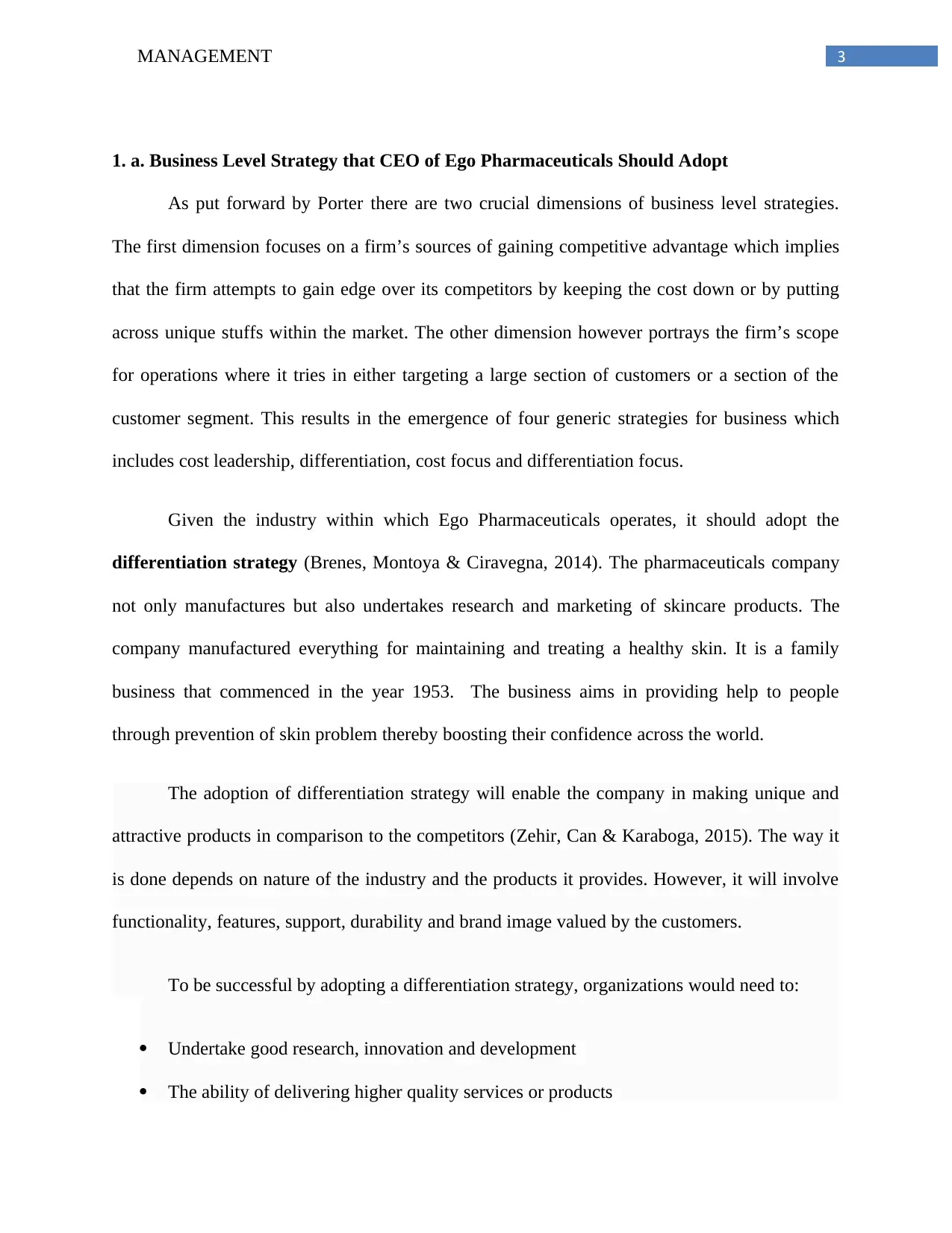
3MANAGEMENT
1. a. Business Level Strategy that CEO of Ego Pharmaceuticals Should Adopt
As put forward by Porter there are two crucial dimensions of business level strategies.
The first dimension focuses on a firm’s sources of gaining competitive advantage which implies
that the firm attempts to gain edge over its competitors by keeping the cost down or by putting
across unique stuffs within the market. The other dimension however portrays the firm’s scope
for operations where it tries in either targeting a large section of customers or a section of the
customer segment. This results in the emergence of four generic strategies for business which
includes cost leadership, differentiation, cost focus and differentiation focus.
Given the industry within which Ego Pharmaceuticals operates, it should adopt the
differentiation strategy (Brenes, Montoya & Ciravegna, 2014). The pharmaceuticals company
not only manufactures but also undertakes research and marketing of skincare products. The
company manufactured everything for maintaining and treating a healthy skin. It is a family
business that commenced in the year 1953. The business aims in providing help to people
through prevention of skin problem thereby boosting their confidence across the world.
The adoption of differentiation strategy will enable the company in making unique and
attractive products in comparison to the competitors (Zehir, Can & Karaboga, 2015). The way it
is done depends on nature of the industry and the products it provides. However, it will involve
functionality, features, support, durability and brand image valued by the customers.
To be successful by adopting a differentiation strategy, organizations would need to:
Undertake good research, innovation and development
The ability of delivering higher quality services or products
1. a. Business Level Strategy that CEO of Ego Pharmaceuticals Should Adopt
As put forward by Porter there are two crucial dimensions of business level strategies.
The first dimension focuses on a firm’s sources of gaining competitive advantage which implies
that the firm attempts to gain edge over its competitors by keeping the cost down or by putting
across unique stuffs within the market. The other dimension however portrays the firm’s scope
for operations where it tries in either targeting a large section of customers or a section of the
customer segment. This results in the emergence of four generic strategies for business which
includes cost leadership, differentiation, cost focus and differentiation focus.
Given the industry within which Ego Pharmaceuticals operates, it should adopt the
differentiation strategy (Brenes, Montoya & Ciravegna, 2014). The pharmaceuticals company
not only manufactures but also undertakes research and marketing of skincare products. The
company manufactured everything for maintaining and treating a healthy skin. It is a family
business that commenced in the year 1953. The business aims in providing help to people
through prevention of skin problem thereby boosting their confidence across the world.
The adoption of differentiation strategy will enable the company in making unique and
attractive products in comparison to the competitors (Zehir, Can & Karaboga, 2015). The way it
is done depends on nature of the industry and the products it provides. However, it will involve
functionality, features, support, durability and brand image valued by the customers.
To be successful by adopting a differentiation strategy, organizations would need to:
Undertake good research, innovation and development
The ability of delivering higher quality services or products
Paraphrase This Document
Need a fresh take? Get an instant paraphrase of this document with our AI Paraphraser
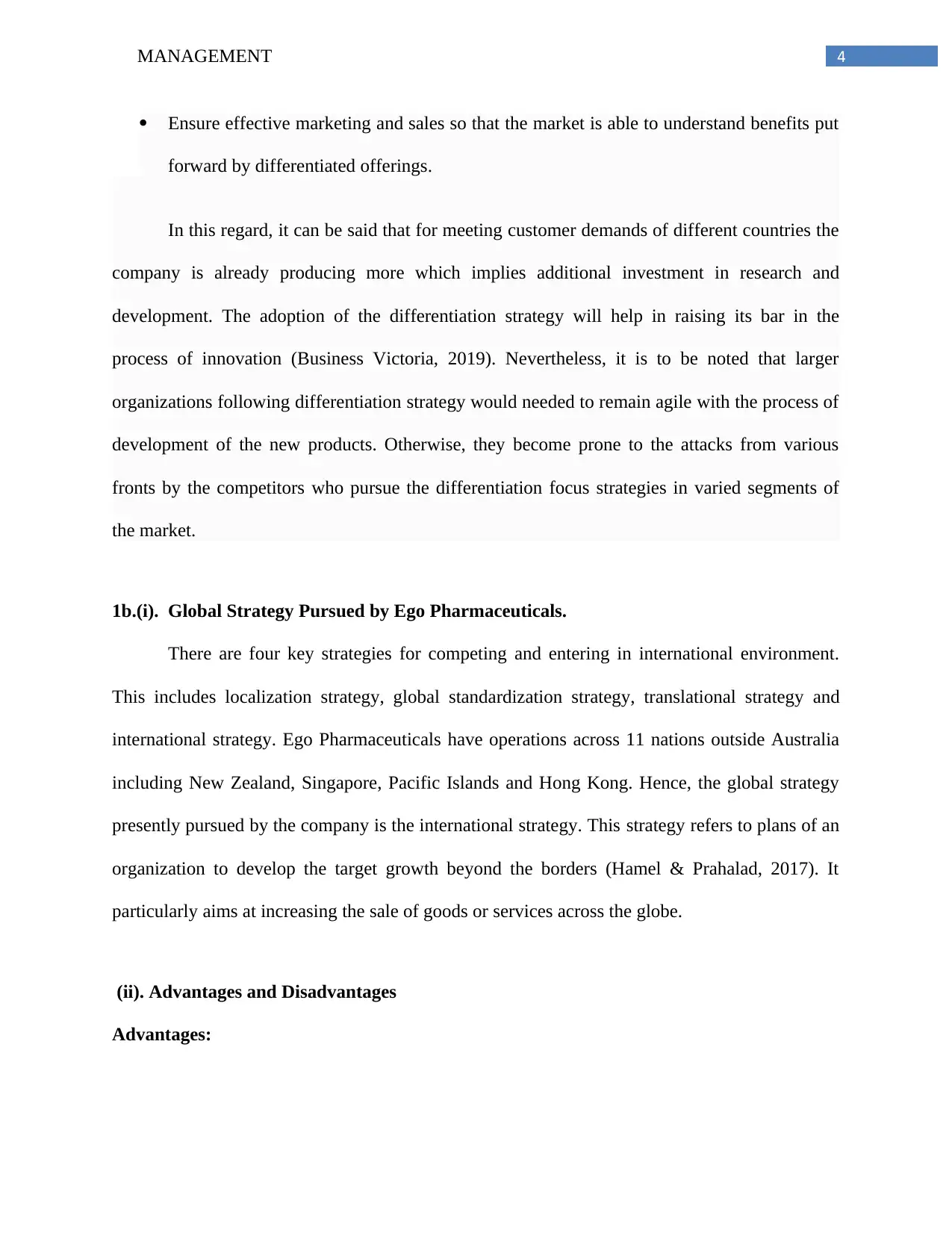
4MANAGEMENT
Ensure effective marketing and sales so that the market is able to understand benefits put
forward by differentiated offerings.
In this regard, it can be said that for meeting customer demands of different countries the
company is already producing more which implies additional investment in research and
development. The adoption of the differentiation strategy will help in raising its bar in the
process of innovation (Business Victoria, 2019). Nevertheless, it is to be noted that larger
organizations following differentiation strategy would needed to remain agile with the process of
development of the new products. Otherwise, they become prone to the attacks from various
fronts by the competitors who pursue the differentiation focus strategies in varied segments of
the market.
1b.(i). Global Strategy Pursued by Ego Pharmaceuticals.
There are four key strategies for competing and entering in international environment.
This includes localization strategy, global standardization strategy, translational strategy and
international strategy. Ego Pharmaceuticals have operations across 11 nations outside Australia
including New Zealand, Singapore, Pacific Islands and Hong Kong. Hence, the global strategy
presently pursued by the company is the international strategy. This strategy refers to plans of an
organization to develop the target growth beyond the borders (Hamel & Prahalad, 2017). It
particularly aims at increasing the sale of goods or services across the globe.
(ii). Advantages and Disadvantages
Advantages:
Ensure effective marketing and sales so that the market is able to understand benefits put
forward by differentiated offerings.
In this regard, it can be said that for meeting customer demands of different countries the
company is already producing more which implies additional investment in research and
development. The adoption of the differentiation strategy will help in raising its bar in the
process of innovation (Business Victoria, 2019). Nevertheless, it is to be noted that larger
organizations following differentiation strategy would needed to remain agile with the process of
development of the new products. Otherwise, they become prone to the attacks from various
fronts by the competitors who pursue the differentiation focus strategies in varied segments of
the market.
1b.(i). Global Strategy Pursued by Ego Pharmaceuticals.
There are four key strategies for competing and entering in international environment.
This includes localization strategy, global standardization strategy, translational strategy and
international strategy. Ego Pharmaceuticals have operations across 11 nations outside Australia
including New Zealand, Singapore, Pacific Islands and Hong Kong. Hence, the global strategy
presently pursued by the company is the international strategy. This strategy refers to plans of an
organization to develop the target growth beyond the borders (Hamel & Prahalad, 2017). It
particularly aims at increasing the sale of goods or services across the globe.
(ii). Advantages and Disadvantages
Advantages:

5MANAGEMENT
1. Helps in Expanding the Target Customers: The access to the international market
not only puts across newer branding opportunities that enable the products in attracting newer
prospects and customers (Verbeke, 2013).
2. Leads to Diversification of the Business: Tapping into the international market helps
in offsetting the losses suffered during the economic downturn on domestic front. Establishment
of a thriving overseas business helps in sustaining the domestic business for a longer amount of
time.
Disadvantages:
1. Challenges of the Foreign Culture: It has found that cultural differences across various
nations can derail the marketing efforts while the differences in the language can skew the marketing
message (Mazur et al., 2016).
2. Challenges of Government Regulations: The regulatory requirements of the
government vary across the countries that might sometime hinder the pharmaceutical company in
value to the consumer while incur massive across the supply chain.
1. Helps in Expanding the Target Customers: The access to the international market
not only puts across newer branding opportunities that enable the products in attracting newer
prospects and customers (Verbeke, 2013).
2. Leads to Diversification of the Business: Tapping into the international market helps
in offsetting the losses suffered during the economic downturn on domestic front. Establishment
of a thriving overseas business helps in sustaining the domestic business for a longer amount of
time.
Disadvantages:
1. Challenges of the Foreign Culture: It has found that cultural differences across various
nations can derail the marketing efforts while the differences in the language can skew the marketing
message (Mazur et al., 2016).
2. Challenges of Government Regulations: The regulatory requirements of the
government vary across the countries that might sometime hinder the pharmaceutical company in
value to the consumer while incur massive across the supply chain.
⊘ This is a preview!⊘
Do you want full access?
Subscribe today to unlock all pages.

Trusted by 1+ million students worldwide
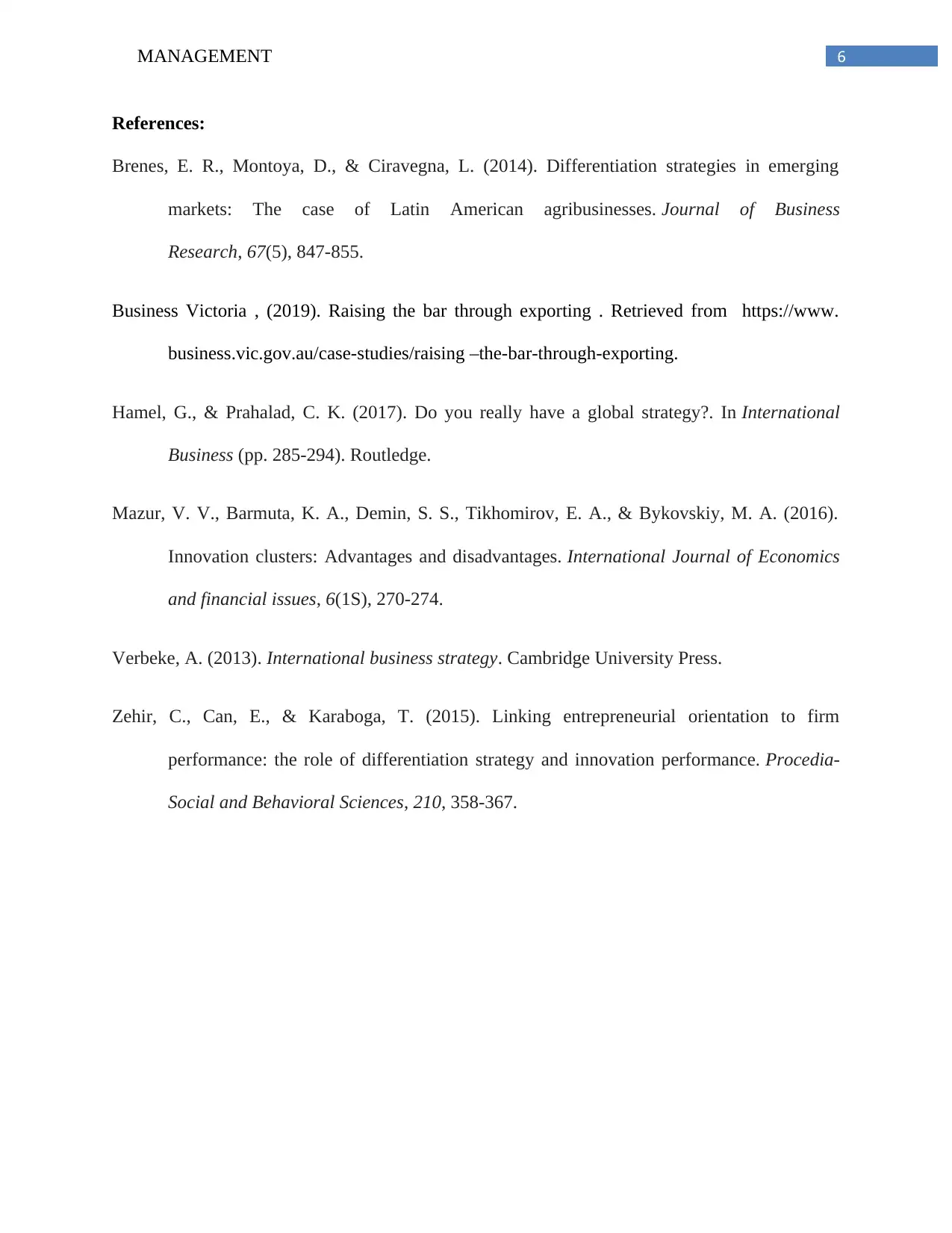
6MANAGEMENT
References:
Brenes, E. R., Montoya, D., & Ciravegna, L. (2014). Differentiation strategies in emerging
markets: The case of Latin American agribusinesses. Journal of Business
Research, 67(5), 847-855.
Business Victoria , (2019). Raising the bar through exporting . Retrieved from https://www.
business.vic.gov.au/case-studies/raising –the-bar-through-exporting.
Hamel, G., & Prahalad, C. K. (2017). Do you really have a global strategy?. In International
Business (pp. 285-294). Routledge.
Mazur, V. V., Barmuta, K. A., Demin, S. S., Tikhomirov, E. A., & Bykovskiy, M. A. (2016).
Innovation clusters: Advantages and disadvantages. International Journal of Economics
and financial issues, 6(1S), 270-274.
Verbeke, A. (2013). International business strategy. Cambridge University Press.
Zehir, C., Can, E., & Karaboga, T. (2015). Linking entrepreneurial orientation to firm
performance: the role of differentiation strategy and innovation performance. Procedia-
Social and Behavioral Sciences, 210, 358-367.
References:
Brenes, E. R., Montoya, D., & Ciravegna, L. (2014). Differentiation strategies in emerging
markets: The case of Latin American agribusinesses. Journal of Business
Research, 67(5), 847-855.
Business Victoria , (2019). Raising the bar through exporting . Retrieved from https://www.
business.vic.gov.au/case-studies/raising –the-bar-through-exporting.
Hamel, G., & Prahalad, C. K. (2017). Do you really have a global strategy?. In International
Business (pp. 285-294). Routledge.
Mazur, V. V., Barmuta, K. A., Demin, S. S., Tikhomirov, E. A., & Bykovskiy, M. A. (2016).
Innovation clusters: Advantages and disadvantages. International Journal of Economics
and financial issues, 6(1S), 270-274.
Verbeke, A. (2013). International business strategy. Cambridge University Press.
Zehir, C., Can, E., & Karaboga, T. (2015). Linking entrepreneurial orientation to firm
performance: the role of differentiation strategy and innovation performance. Procedia-
Social and Behavioral Sciences, 210, 358-367.
Paraphrase This Document
Need a fresh take? Get an instant paraphrase of this document with our AI Paraphraser

7MANAGEMENT
1 out of 8
Related Documents
Your All-in-One AI-Powered Toolkit for Academic Success.
+13062052269
info@desklib.com
Available 24*7 on WhatsApp / Email
![[object Object]](/_next/static/media/star-bottom.7253800d.svg)
Unlock your academic potential
Copyright © 2020–2025 A2Z Services. All Rights Reserved. Developed and managed by ZUCOL.




